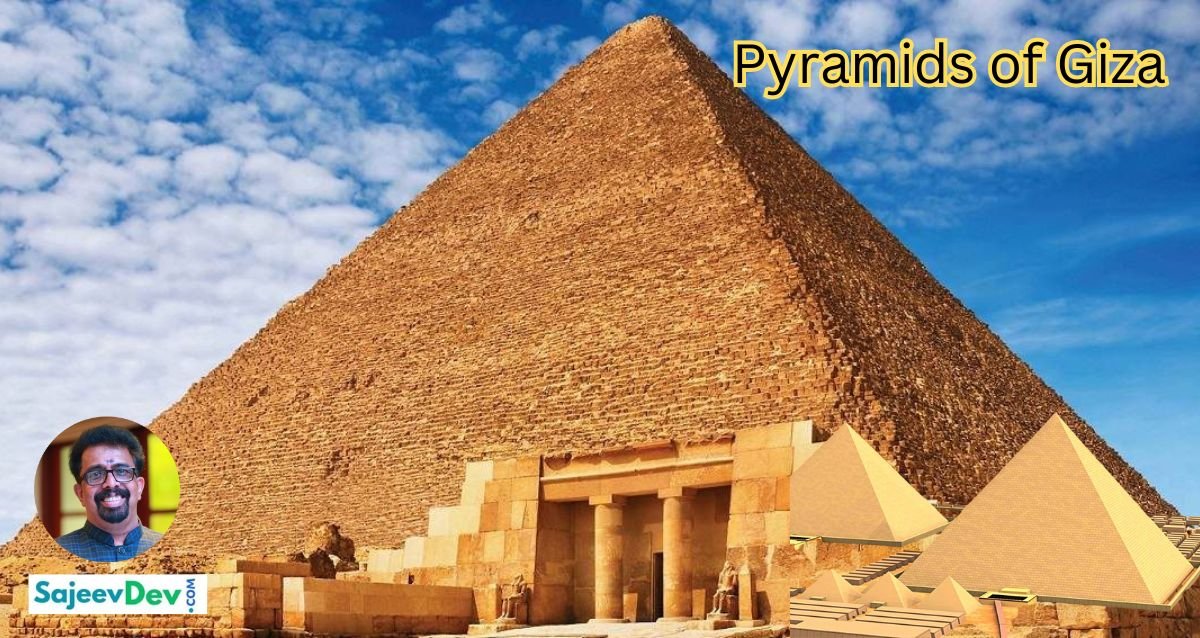The Great Pyramid of Giza stands as a monumental testimony to ancient Egyptian ingenuity
The Great Pyramid of Giza stands as a monumental testimony to ancient Egyptian ingenuity, representing both an architectural marvel and a cultural icon. Constructed during the Fourth Dynasty of the Old Kingdom, around 2580–2560 BCE, this colossal structure was originally built as a tomb for the Pharaoh Khufu (also known as Cheops). Its precise construction and enduring grandeur have fascinated historians, archaeologists, and tourists for millennia.
As the only surviving wonder of the original Seven Wonders of the Ancient World, the Great Pyramid of Giza holds a unique place in human history. Its sheer magnitude—initially standing at 146.6 meters (481 feet)—and the precision with which it was built, speaks volumes about the advanced engineering capabilities of the ancient Egyptians. The pyramid was part of a larger complex that included two mortuary temples, three smaller pyramids for queens, and various other structures, all designed to support its central function as a royal tomb.
In the modern age, the Great Pyramid continues to captivate imaginations and inspire research. With its intricate network of chambers and passageways, the pyramid has sparked countless theories about its construction techniques, purpose, and the lives of those who built it. This towering edifice is not just a relic of the past; it serves as a tangible link to a sophisticated and enigmatic civilization that continues to intrigue scholars and the general public alike.
The cultural impact of the Great Pyramid of Giza is undeniable. It has been a symbol of Egypt throughout history, featured in ancient texts, modern literature, and popular media. As an enduring emblem of both human achievement and the mysteries of our past, the Great Pyramid invites us to explore the depths of ancient Egyptian culture and its enduring legacy.
Historical Background
The Great Pyramid of Giza, an epitome of ancient Egyptian architectural prowess, was constructed during the reign of Pharaoh Khufu, also known as Cheops, around 2580-2560 BCE. This monumental endeavor was primarily intended to serve as a tomb for Khufu, aligning with the ancient Egyptian belief in the afterlife and the importance of preserving the pharaoh’s body and belongings for eternity. Pharaoh Khufu, the second ruler of Egypt’s Fourth Dynasty, governed a realm characterized by significant advancements in cultural, religious, and architectural domains.
Khufu’s reign marked a period of prosperity within the broader era known as the Old Kingdom, often referred to as the “Age of the Pyramids.” The Old Kingdom, spanning roughly from 2686 to 2181 BCE, witnessed the zenith of pyramid construction, with the Great Pyramid standing as the most illustrious achievement of this epoch. This period was not merely about constructing grand structures; it encapsulated a profound understanding of mathematics, astronomy, and engineering principles that enabled such feats. The Great Pyramid’s alignment with the cardinal points and its precise proportions underscored the advanced knowledge and meticulous planning involved in its creation.
As one of ancient Egypt’s most enigmatic leaders, Khufu’s legacy is enshrined in this colossal edifice. However, much about his life and rule remains shrouded in mystery. Historical records from the Old Kingdom period are sparse, leaving archaeologists and historians reliant on later accounts, such as those by the Greek historian Herodotus, to piece together Khufu’s narrative. These accounts, combined with archaeological findings, suggest a ruler who commanded immense resources and labor, orchestrating a workforce that included skilled artisans, engineers, and laborers.
In the broader context of ancient Egyptian history, the construction of the Great Pyramid symbolizes the zenith of architectural and cultural evolution during the Old Kingdom. It serves as a testament to the enduring legacy of Pharaoh Khufu and the sophisticated civilization that thrived along the Nile River thousands of years ago. Through ongoing research and exploration, new insights continue to emerge, shedding light on the life and times of one of ancient Egypt’s most iconic pharaohs and his monumental pyramid.
Architectural Marvel
The Great Pyramid of Giza stands as an unparalleled achievement in architectural and engineering history. Known also as the Pyramid of Khufu, this formidable structure originally rose to a height of approximately 146 meters (480 feet), although it now stands at about 138 meters (454 feet) due to the loss of the outer casing stones. The base spans about 230 meters (756 feet) on each side, covering over 13 acres with remarkably precise alignment to the cardinal points of the compass.
What sets the Great Pyramid apart is not only its sheer size but also the remarkable precision of its construction. The ancient Egyptians employed advanced methods to achieve an extraordinary level of accuracy. Each of the pyramid’s over two million blocks of limestone and granite, some weighing as much as 80 tons, was meticulously cut, transported, and assembled. This task required an estimated workforce of tens of thousands, ranging from skilled laborers to seasonal workers and slaves.
To ensure the pyramid’s structural integrity, the Egyptians developed sophisticated levelling techniques. They devised a means to achieve near-perfect horizontality for the base, using water-filled trenches as a primitive level tool. Copper chisels, stone hammers, and wooden sledges were among the primary tools used in quarrying and shaping the stones. The precision with which these tools were employed has left modern engineers astounded, as the joints between the blocks are so tight that not even a razor blade can fit between them.
Additionally, the design of the internal chambers and passageways exhibits an advanced understanding of engineering principles. For instance, the ascending passage, grand gallery, and burial chamber were constructed with a level of detail that ensured not only the pyramid’s stability but also the protection of the pharaoh’s remains. The alignment of these features with celestial bodies further exemplified the Egyptians’ sophisticated grasp of astronomy and its integration into their architectural endeavors.
Engineering Techniques
The construction of the Great Pyramid of Giza remains a marvel of ancient engineering, reflecting the ingenuity and skills of its builders. Despite being constructed over 4,500 years ago, the techniques employed continue to intrigue modern engineers and scholars. Examining the process starts with the sourcing and transportation of the limestone blocks, some of which weighed as much as 80 tons. Quarrying these immense blocks from local resources, the builders transported them primarily using sledges and manpower, lubricating the pathways with water to reduce friction.
One of the pyramid’s standout features is its precise alignment with the cardinal points, showcasing the builders’ advanced understanding of astronomical observations. The structure is oriented almost perfectly with the north-south axis, with only a minimal deviation of less than 0.05 degrees. Achieving such an alignment suggests the usage of sophisticated tools or methods, perhaps involving the observation of the stars such as Polaris and Thuban.
Theories regarding the construction process have evolved over the years, with significant research devoted to understanding how the immense stones were lifted and positioned. The most predominant hypothesis involves the use of a ramp system. Several variations of ramp designs have been proposed, including straight, zigzagging, and circular ramps, each with unique advantages for lifting the blocks to the necessary height. The practicality of each ramp type continues to be debated among archaeologists and engineers.
Besides ramps, other mechanisms might have been employed. Levering techniques could have been used to adjust the blocks into their precise positions, emphasizing the builders’ proficiency in manipulating colossal elements with rudimentary tools. The Great Pyramid’s enduring presence is a testament to the successful application of these engineering techniques, representing a synthesis of human endeavor and technological prowess in ancient Egypt.
Symbolism and Religious Significance
The Great Pyramid of Giza is not just an architectural marvel but also a significant cultural and religious symbol for the ancient Egyptians. Its construction was deeply interwoven with their religious beliefs, which prominently revolved around the afterlife and the journey of the soul. The pyramid’s very shape, a monumental stone structure pointing towards the sky, symbolizes the rays of the sun, reinforcing the idea of ascension to the heavens.
This connection is further emphasized by the pyramid’s precise alignment with the cardinal points and certain constellations. For instance, the pyramid is situated in such a way that its sides are closely aligned to the four cardinal directions—north, south, east, and west. Moreover, many researchers believe that the positions of the pyramids correspond to the stars in the Orion constellation, reflecting a direct link between the architectural layout and the cosmos. This celestial alignment underscores the ancient Egyptians’ belief in the afterlife and the pharaoh’s journey to the stars.
The Great Pyramid functioned as a monumental tomb, echoing the Egyptian conception of the afterlife. The internal passageways and chambers were meticulously designed to guide the soul of the deceased pharaoh through the underworld and into eternal life among the gods. Hieroglyphics and wall inscriptions within the pyramid depict various religious texts, including passages from the Pyramid Texts, which provide spells and instructions to aid the pharaoh on his journey in the afterlife.
Moreover, the placement of the Great Pyramid within the Giza plateau adds another layer of symbolic meaning. Positioned on the west bank of the Nile River, where the sun sets, it aligns with the ancient Egyptian belief that the west was the land of the dead. This geographical placement underscores the pyramid’s role as a gateway to the afterlife.
In essence, the Great Pyramid of Giza stands as a testament to the profound religious and cultural practices of ancient Egypt. Its symbolism—ranging from its geometric form to its celestial alignments and geographical placement—reflects the intricate belief system surrounding death, the afterlife, and the divine power of the pharaohs.
The Great Pyramid’s Cultural Impact Over Time
The Great Pyramid of Giza stands as an enduring testament to ancient Egyptian innovation, perseverance, and cultural sophistication. This monumental structure, originally constructed as a tomb for Pharaoh Khufu, has transcended its original purpose and etched itself indelibly into the annals of human history. Over millennia, the Great Pyramid has been a beacon of fascination, influencing various civilizations and inspiring countless scholarly endeavors.
In antiquity, the Great Pyramid was part of a broader complex of structures that illustrated the Egyptians’ mastery of engineering, mathematics, and astronomy. Its imposing presence garnered awe and respect from neighboring societies, including the Greeks and Romans, who visited and studied it. The enigmatic nature of its construction prompted early historians, such as Herodotus and Strabo, to document their observations, albeit with a mix of facts and speculative interpretations.
With the advent of the Islamic Golden Age, scholars like Al-Maqrizi delved into the pyramid’s history, drawing connections to ancient knowledge and scientific discovery. This era saw the diffusion of the Great Pyramid’s lore beyond Egypt, embedding it within the broader Islamic cultural and intellectual traditions. Through translations and adaptations, the significance of the pyramid transcended geographical boundaries.
The Renaissance marked a renewed European fascination with ancient Egyptian civilization. Explorers, archaeologists, and antiquarians, driven by curiosity and a quest for knowledge, embarked on expeditions to uncover the secrets of the Great Pyramid. In the 19th and 20th centuries, scholarly research advanced with more systematic archaeological methods, leading to substantive insights about its construction techniques, purpose, and the civilization that built it.
In the modern era, the Great Pyramid continues to captivate the global imagination. It stands as a cultural icon, reflecting humanity’s enduring quest for understanding and achievement. Scholars and enthusiasts alike ponder its historical, architectural, and astronomical significance, ensuring that the narrative of the Great Pyramid of Giza remains a vibrant part of our collective consciousness.
Tourism and Modern-Day Importance
The Great Pyramid of Giza stands as a beacon of ancient wonder in modern times, drawing millions of tourists annually from all corners of the globe. This architectural marvel is not merely a static monument of the past but continues to play a dynamic role in contemporary culture. Each year, the Great Pyramid’s imposing presence and historical significance lure throngs of visitors, eager to witness one of the Seven Wonders of the Ancient World. These pilgrims of history significantly bolster the local economy, fueling an array of businesses—from guided tours and local craft shops to larger hospitality and transportation services.
Tourism around the Great Pyramid generates substantial revenue, contributing to the livelihood of countless individuals. In this way, the pyramid serves as both a symbol of Egypt’s ancient heritage and a critical modern economic resource. Hotels, restaurants, and tour operators thrive on the influx of international and domestic tourists, creating a symbiotic relationship between the ancient structure and today’s economy.
However, the intersection of tourism and preservation presents an ongoing challenge. The Great Pyramid requires continuous conservation efforts to mitigate the wear and tear inflicted by the sheer volume of annual visitors. Erosion, foot traffic, and environmental factors pose persistent threats to its structural integrity. Consequently, meticulous preservation strategies are implemented to ensure that future generations may also marvel at its grandeur. Conservationists work diligently to balance the need for public access with the necessity of safeguarding this historical treasure.
Modern technologies, such as digital mapping and 3D reconstruction, play an instrumental role in these conservation efforts, allowing experts to monitor and repair the pyramid with greater precision. As such, the Great Pyramid of Giza remains an enduring testament to human ingenuity, not only standing firm against the ravages of time but also continuing to shape contemporary life and culture.
The Great Pyramid’s Legacy
The Great Pyramid of Giza stands as a monumental testament to human ingenuity and creativity, consistently inspiring awe across generations. Its legacy resonates profoundly within global culture and continues to be a focal point in a plethora of fields, ranging from engineering and architecture to art and popular media. The pyramid’s impressive dimensions and technical precision have cemented its status not only as an architectural marvel but also as a symbol of human perseverance and innovation.
Across popular imagination, the Great Pyramid conjures images of ancient wisdom and the enduring quest for knowledge. In literature, films, and television, the pyramid often serves as a backdrop, weaving narratives of mystery and adventure. Writers and filmmakers have long been drawn to its enigmatic allure, leveraging its mystical aura to captivate audiences worldwide. This widespread representation underscores the pyramid’s impact in shaping stories and cultural motifs far beyond its geographical confines.
In the realm of engineering and design, the Great Pyramid continues to be a source of inspiration and study. Modern architects and engineers admire its durability and structural ingenuity, seeking to unravel the secrets behind its construction. By examining ancient techniques, contemporary professionals aspire to innovate and push the boundaries of current architectural practices. The pyramid serves as a bridge connecting the distant past with present-day advancements, fostering a continuous dialogue between eras.
Moreover, the pyramid’s influence extends into the arts, where it has been immortalized in paintings, sculptures, and new media art forms. Artists are drawn to its majestically simple yet profound geometry, utilizing it as a muse to explore themes of time, eternity, and human achievement. The Great Pyramid embodies an archetype of artistic inspiration, deeply embedded within the collective psyche across different cultures and epochs.
Ultimately, the enduring legacy of the Great Pyramid of Giza lies in its ability to inspire wonder and reflection. Reflecting the pinnacle of ancient achievements, it fosters a connection with humanity’s shared past while continuously sparking new avenues of creativity and discovery in the present and future.









